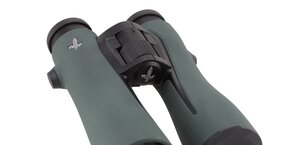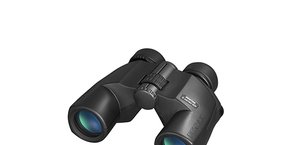Alpen Optics Apex 8x42
The Apex series consists of roof-prismatic models in a variety of configurations including 8x32, 8x42, 10x42, 8.5x50, 10x50 and 12x50. The prisms are made of BaK-4 glass in the Schmidt-Pechan system. Metallic HR coatings cover reflective surfaces and additionally a phase correcting PXA coating was put on the prisms. All the air-to-glass surfaces in the binoculars of this series are covered by multilayer antireflection coatings.
The binoculars are closed in a light housing, covered by rubber armour, waterproof and nitrogen-filled. The binoculars are guaranteed for life.
| Magnification | Lens diameter | Angular field of view | Prisms | Eye relief | Weight | Price |
|---|---|---|---|---|---|---|
| 8 | 42 | 114/1000(6.5o) | BaK-4/roof | 20 mm | 625 g | 1449 PLN |
Summary
Pros:
- small, light and compact barrel,
- well-corrected astigmatism,
- slight coma,
- not very big brightness loss at the edge of the field of view,
- good whiteness reproduction,
- very short minimum focus distance,
- good quality of prisms,
- very nice blackening and cleanliness inside the inner tubes,
- lifetime warranty.
Cons:
- slippery rubber on the housing,
- clearly visible chromatic aberration at the edge of the field,
- truncated exit pupils,
- too low transmission in the blue part of the spectrum,
- field of vision definitely too small.
Undoubtedly the light weight and handiness of the tested binoculars is an asset. Many nature lovers, not burdened by a heavy instrument during long trips, will fully appreciate that fact. Everything comes at a price, though. The small weight and dimensions in roof-prism binoculars most often mean a limited size of the prisms. Although in the case of the Apex the constructors tried to diminish losses to the minimum but they can be still noticed. The exit pupils are truncated, small prisms forced a small apparent field of the eyepieces and too narrow field of view of the whole binoculars. What’s more, the field’s edge could have been sharper and its chromatic aberration - lower.
On the other hand, though, the producer managed to pack a lot of advantages into an indeed small barrel. The binoculars correct coma and astigmatism well, the whiteness reproduction is good and the collimation – correct; the device focuses already from 1.3 meters, its inside blackening and work against bright light are relatively good.
By its Rainier and Apex series the Alpen company complemented its offer very well. Rainiers are heavy but constructed with no compromises - clearly intended for people who care more about optical properties than small weight. The situation is reversed in the case of the Apexes. These binoculars are for people who want to have a small, light device but know that it means worse optical properties than in better and more expensive models.
The graph below, with the binoculars’ transmission curve depending on the wavelength, shows that, compared to the better series, the producer saved on coatings too. We deal here with lately popular greenish multi-layer coatings which give transmission at the level of 80-85% so even about 10% less than the high-end binoculars. The graph explains well where the greenish tinge of the coatings comes from. The binoculars reach the highest transmission of about 86% for the red light, that value decreases to less than 81% in the middle of the visible spectrum, and for the green and blue light it is even lower than 80%. As exactly the biggest number of these photons is reflected in the centers’ border lines, the coatings seem dark-green to us.
 |












